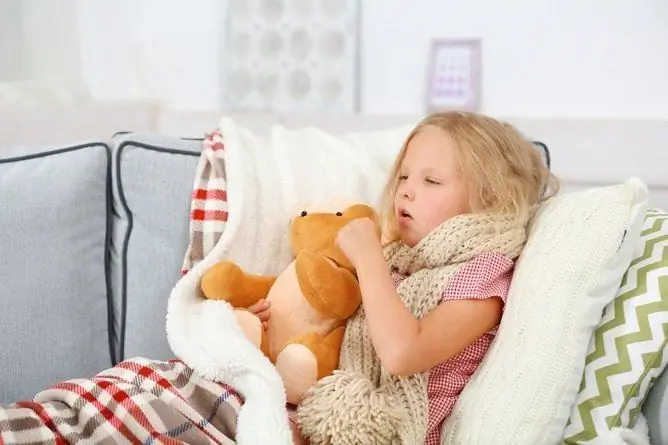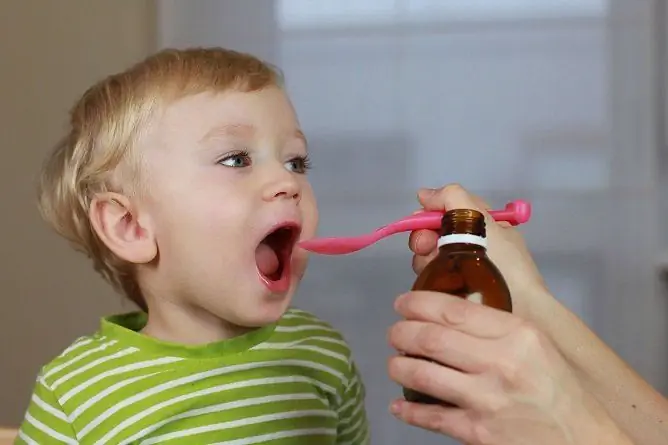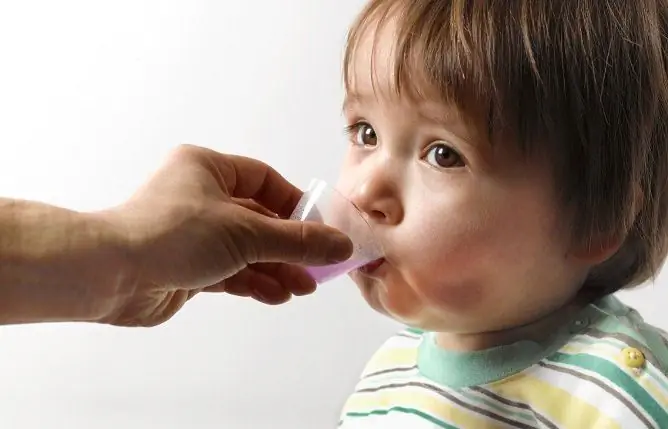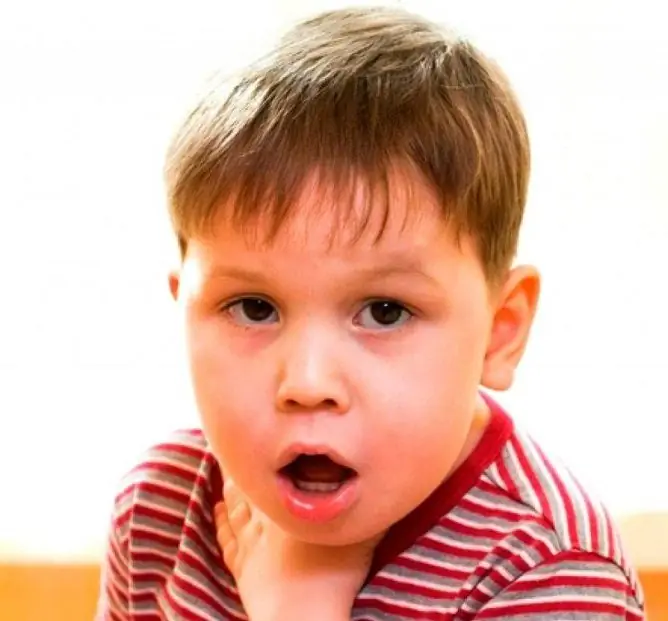- Author Rachel Wainwright [email protected].
- Public 2024-01-15 19:51.
- Last modified 2025-11-02 20:14.
How to treat a child with a barking cough and fever at home
The content of the article:
- How to treat a barking dry cough in a child with a fever?
- Folk remedies
- How to recognize a barking cough
- The reasons
- Symptoms
- Diagnostics
- Prevention
- Video
It is impossible to give an unequivocal universal answer to the question of how to treat a barking cough in a child with a fever, since its occurrence can be triggered by a number of bacterial and viral diseases of the respiratory system. Barking in medicine is called a rough, dry, tearful cough, which sounds like a dog barking.
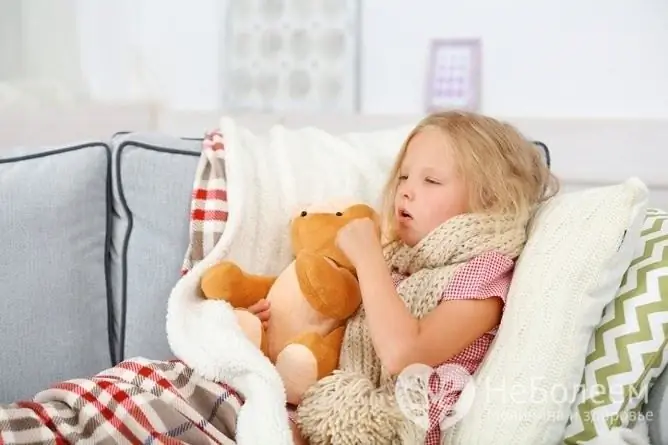
If a child has a rough cough, accompanied by a fever, it is necessary to see a doctor
How to treat a barking dry cough in a child with a fever?
Barking cough most often occurs in children with laryngitis. This disease is often complicated by croup, in which respiratory failure can occur and rapidly progress. Therefore, when an attack of a rough, dry, unproductive cough occurs, combined with shortness of breath, it is important to immediately call an ambulance to the sick baby.
The first thing to do before the doctor arrives is to try to calm the child down and provide him with fresh air. A warm (not hot) drink can be offered to the child to reduce sore throat. If you have a nebulizer at home, you can do inhalation with a solution of soda or alkaline mineral water without gas.
Medical treatment is carried out only as directed and under the supervision of a physician. The following drugs may be prescribed:
| Drug group | Names | Mechanism of action |
| Antihistamines | Zodak, Zyrtek, Fenistil | Reducing swelling of the mucous membrane, preventing allergies to drugs from other groups |
| Mucolytics and expectorants | Althea root syrup, Herbion, Ambrobene, Lazolvan | Helps to liquefy thick phlegm and improve its coughing |
| Sore throat remedies | Faringosept, Strepsils | Eliminate soreness when swallowing, have an antibacterial effect |
| Non-steroidal anti-inflammatory drugs | Paracetamol, Panadol, Ibuklin | Reduces body temperature, reduces the activity of the inflammatory process |
| Hypertonic solutions | Glucose solution 20%, calcium gluconate solution 10% | Reduce swelling of the laryngeal mucosa |
| Corticosteroids | Prednisolone, Dexamethasone |
They have anti-edema, anti-inflammatory and antihistamine effects |
| Tranquilizers | Seduxen, Relanium | They have a pronounced sedative effect |
If, against the background of the therapy, the cough softens and sputum begins to appear, this is evidence of its effectiveness. In this case, the child can be left at home and monitored by a local doctor. With an increase in the phenomena of respiratory failure, urgent hospitalization in a specialized hospital is indicated.
Antibiotics for barking coughs are prescribed only if it is caused by a bacterial infection or there is a high risk of its attachment.
Folk remedies
With a barking cough, uncomplicated by severe shortness of breath, folk remedies have a good therapeutic effect. But they should be used only after consulting a doctor, as they can provoke the development of an allergic reaction.
The most effective methods are:
- Milk with carrots. Peel medium-sized carrots, wash under running water and scald with boiling water. Grate on the finest grater. Pour the resulting puree into a glass of boiling milk. Insist for 20 minutes. Strain. Milk is given warm before bedtime.
- Milk with egg. Lightly beat the egg yolk with a mixer and pour a glass of very hot milk and a teaspoon of butter into it in a thin stream. Cool to room temperature. Add 1-2 teaspoons of honey and stir well. Take a tablespoon warm 5-6 times a day.
- Onion broth. Wash two large onions well and place in a saucepan. Pour a liter of cold water, add a glass of granulated sugar. Bring to a boil and simmer for half an hour over low heat. Strain the broth and take a tablespoon 3-5 times a day.
- Radish with sugar. Peel the radish and wash well under running water. Cut into small cubes. Fold, pouring granulated sugar into a small clay pot. Close the lid and bake in the oven for an hour. The liquid formed in the pot should be drained and given to the child 3-4 times a day, a teaspoon.
- Honey oil. Beat with a mixer 100 g of softened butter and gradually, without stopping whipping, add 100 g of honey and 5 g of vanillin to it. Take a teaspoon 3-4 times a day.

Carrot Milk May Be Good For Barking Coughs In Children
How to recognize a barking cough
A barking cough is difficult to confuse with any other type of cough. The attack often occurs at night. The child wakes up and suddenly begins to cough loudly and violently. In addition, the baby may have a number of other symptoms characteristic of a respiratory infection:
- high body temperature;
- a sore throat;
- runny nose;
- conjunctivitis;
- swollen lymph nodes;
- headache and muscle pain;
- general weakness.
The reasons
A barking rough cough accompanies acute inflammation of the larynx (laryngitis) and trachea (tracheitis) caused by various pathogenic microorganisms:
- viruses (influenza, parainfluenza, adenovirus or respiratory syncytial infection);
- bacteria (whooping cough, scarlet fever, diphtheria).
Symptoms
A barking cough does not clear the airways from accumulated phlegm, therefore it is called unproductive. The attack is accompanied by a sore throat, hoarseness.
Against the background of the inflammatory process in the larynx, the edema of the mucous membrane increases. In children, due to the anatomical age-related features of the structure of the respiratory tract, laryngitis may be accompanied by the development of croup, a dangerous condition characterized by shortness of breath.
Depending on the causes of the occurrence, croup is divided into two types:
- true (diphtheria) - occurs as a complication of laryngeal diphtheria;
- false - caused by any pathogenic microorganisms, except for diphtheria bacillus.
The clinical picture of each type of cereal has its own characteristic features:
| Sign | False croup | True croup |
| Vote | Aphonia is absent, hoarseness is not constantly expressed | The hoarseness of the voice gradually increases to complete aphonia |
| Cough | Barking, rude, sonorous | Barking, rude, deaf |
| Raids | Easily removed with a swab or spatula | On the surface of the tonsils, a coating of a dirty gray color is noted. It is difficult to remove and leaves a bleeding surface in its place after removal |
| Cervical lymph nodes | Some lymph nodes are enlarged, painful on palpation | Enlarged, moderately painful on palpation. There is swelling of soft tissues around the nodes |
| Features of the flow | The attack occurs suddenly, mostly at night. The inhalation is noisy, well audible even from a distance. Often the attack ends on its own | Gradually increasing shortness of breath. An attack is never resolved on its own |
A long-lasting barking dry cough poses a serious danger to the child's body, primarily because, against the background of hypoxia, brain tissue and myocardium suffer.
In addition, the development of other complications is possible:
- pleurisy;
- pneumonia;
- emphysema of the lungs;
- pneumothorax.
Diagnostics
Cough in children of a barking nature is not an independent disease, but just a symptom of any disease of the respiratory system. Therefore, when it appears, parents should call the local pediatrician. The doctor will examine the child and, if necessary, prescribe a number of laboratory and instrumental diagnostic tests:
- chest x-ray;
- general blood analysis;
- Ultrasound of the lymph nodes.
Also, the pediatrician can refer the child for consultation to narrow specialists (pulmonologist, infectious disease specialist, otolaryngologist, allergist).

It is necessary to find out the reason for the appearance of a rough cough in a child
Prevention
Prevention of attacks of rough dry cough in children should be aimed at preventing the occurrence of respiratory diseases and includes the following measures:
- hardening procedures;
- playing sports;
- daily walks in the fresh air;
- proper nutrition that meets the age needs of the child;
- timely vaccination against whooping cough, measles, flu.
Video
We offer for viewing a video on the topic of the article.

Elena Minkina Doctor anesthesiologist-resuscitator About the author
Education: graduated from the Tashkent State Medical Institute, specializing in general medicine in 1991. Repeatedly passed refresher courses.
Work experience: anesthesiologist-resuscitator of the city maternity complex, resuscitator of the hemodialysis department.
Found a mistake in the text? Select it and press Ctrl + Enter.

